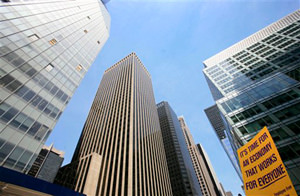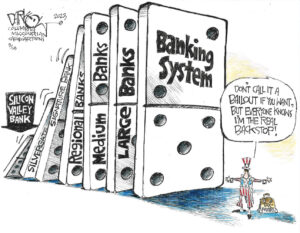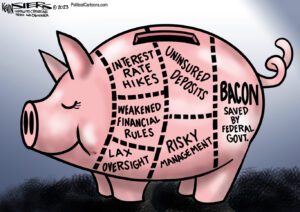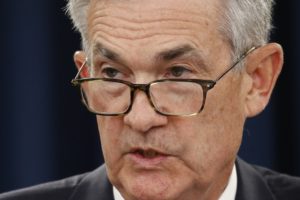Banking Bandits Get Their Reward
By now everybody must know that the top banking executives responsible for our economic meltdown have no shame. Otherwise they would not have dared give themselves such hefty bonuses as a deeply perverse reward for actions that caused millions of Americans to lose their jobs and homes. By now everybody must know that the top banking executives responsible for our economic meltdown have no shame.
By now everybody must know that the top banking executives responsible for our economic meltdown have no shame. Otherwise they would not have dared give themselves such hefty bonuses as a deeply perverse reward for actions that caused millions of Americans to lose their jobs and homes. The $33 billion that the executives of the nine banks bailed out with taxpayer funds paid themselves in 2008 is all one needs to know about the depth of their amorality.
But it also speaks volumes about the inefficiency of a system of rewards that has nothing to do with performance. “No Rhyme or Reason: the ‘Heads I Win, Tails You Lose’ Bank Bonus Culture” is the title of the report by New York’s Attorney Gen. Andrew M. Cuomo unmasking this scandal. It concludes: “ … compensation for bank employees has become unmoored from the banks’ financial performance.”
That would not be of public concern if bank executives and their stockholders would bear the full price of such folly. But not one of those top nine banks that distributed bonuses of at least $1 million to each of 5,000 top executives faced the consequences on their own. Instead, taxpayers were called upon to pony up what will eventually be trillions of dollars to save the banks and the nation from this disaster. As the Cuomo report notes:
“Two firms, Citigroup and Merrill Lynch suffered massive loses of more than $27 billion at each firm. Nevertheless, Citigroup paid out $5.33 billion, in bonuses, and Merrill paid $3.6 billion in bonuses. Together, they lost $54 billion, paid out nearly $9 billion in bonuses and then received TARP bailouts totaling $55 billion. For three other firms—Goldman Sachs, Morgan Stanley, and J.P. Morgan Chase—2008 bonus payments were substantially greater than the banks’ net income.”
In each instance, those bonuses on average more than doubled earnings and were in turn more than doubled by the government bailout in TARP funds. Those funds, and the nonrefundable tens of billions passed on through the AIG bailout and other government programs, come from the very taxpayers already reeling from a banking collapse brought on by reckless lending practices.
Yet the $306 billion in toxic assets that Citigroup — a leader in the irresponsible practices that created such “assets” — managed to pile up are also now guaranteed by taxpayer funds. And being on the public dole didn’t prevent Citigroup CEO Vikram Pandit from “earning” $38 million last year.
The Merrill Lynch bonuses were paid as the company was about to collapse. It was saved at the last minute by being purchased for $50 billion by Bank of America in a deal engineered by the federal government and facilitated by $45 billion in bailout funds to BofA. On Monday, Bank of America agreed to pay $33 million in penalties to the Securities and Exchange Commission to settle an SEC complaint that BofA had deceived shareholders about those billions in bonuses.
One of those handsomely rewarded was Thomas Montag, now with BofA, who received a $39.4 million bonus for his work at Merrill Lynch, a reward for his performance as Merrill’s trading and sales chief, a position in which he presided over the billions in mortgage acquisitions that fueled the company’s downfall.
The banks, considered “too big to fail,” were quickly showered with enormous amounts of money, contributing to a U.S. deficit expected to grow to $1.86 trillion this year. But homeowners are not too big to fail, and they were left to the tender mercies of the very bankers who swindled them with flaky mortgages.
On Tuesday, the Treasury Department criticized the major banks for their abysmally weak effort to aid distressed homeowners who are more than 60 days delinquent on their mortgages. Only 9 percent of those who qualify for assistance under President Obama’s foreclosure prevention plan have been entered into trial programs to determine whether their mortgages will be modified. BofA, one of the major holders of distressed mortgages, has entered only a scant 4 percent of its eligible mortgage holders in the program.
Citigroup has managed to begin the process with 15 percent of those eligible, while Wells Fargo has begun with only 6 percent of its eligible borrowers. Compare that snail speed in helping folks keep their homes with the alacrity with which the federal government responded in bailing out the banks when they got into trouble.
The choice from the beginning of this debacle has been: Do we bail out the banks that caused the problem in the hopes that they will help ordinary folks or do we start with government relief for distressed mortgage holders? The decision to aid the bankers first was based on the assumption that for the first time in their lives they would do the honorable thing and surrender space in the lifeboats to those most vulnerable.
Your support matters…Independent journalism is under threat and overshadowed by heavily funded mainstream media.
You can help level the playing field. Become a member.
Your tax-deductible contribution keeps us digging beneath the headlines to give you thought-provoking, investigative reporting and analysis that unearths what's really happening- without compromise.
Give today to support our courageous, independent journalists.




You need to be a supporter to comment.
There are currently no responses to this article.
Be the first to respond.